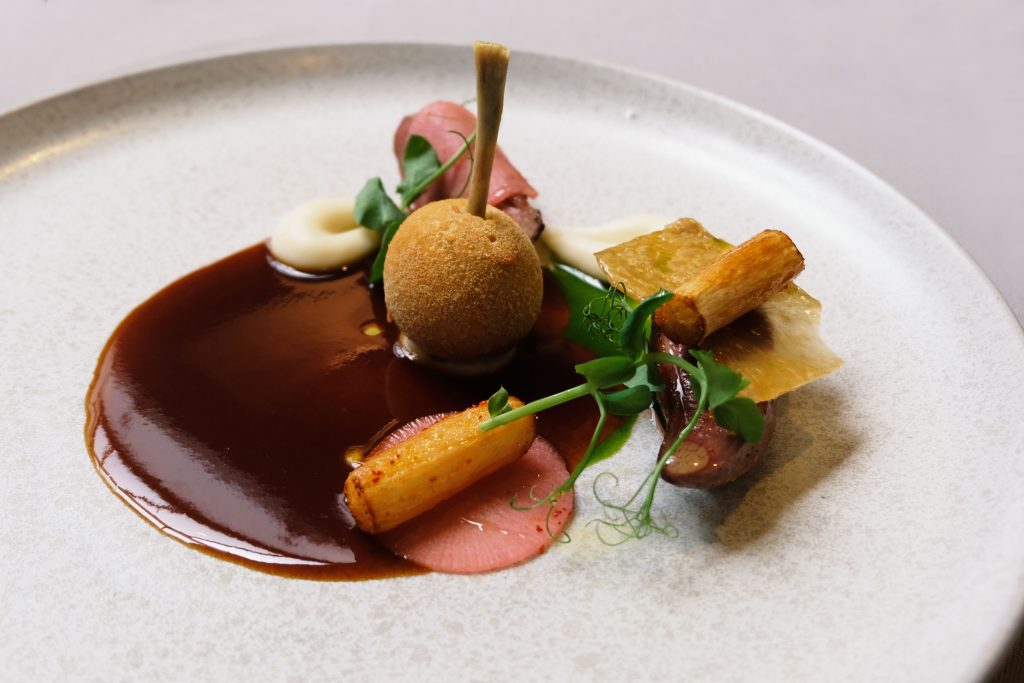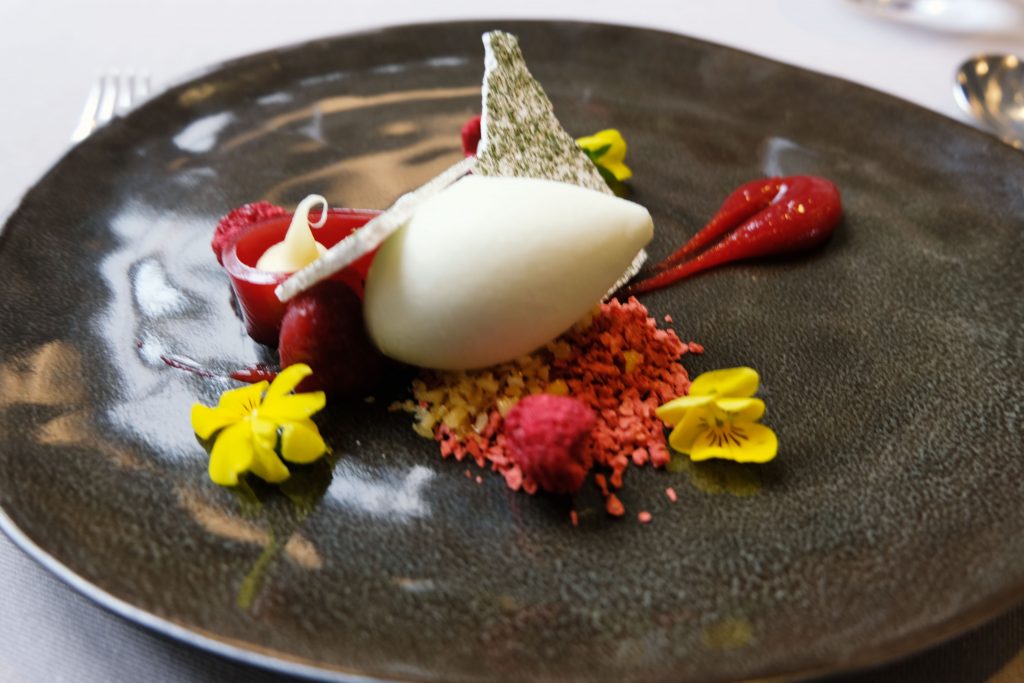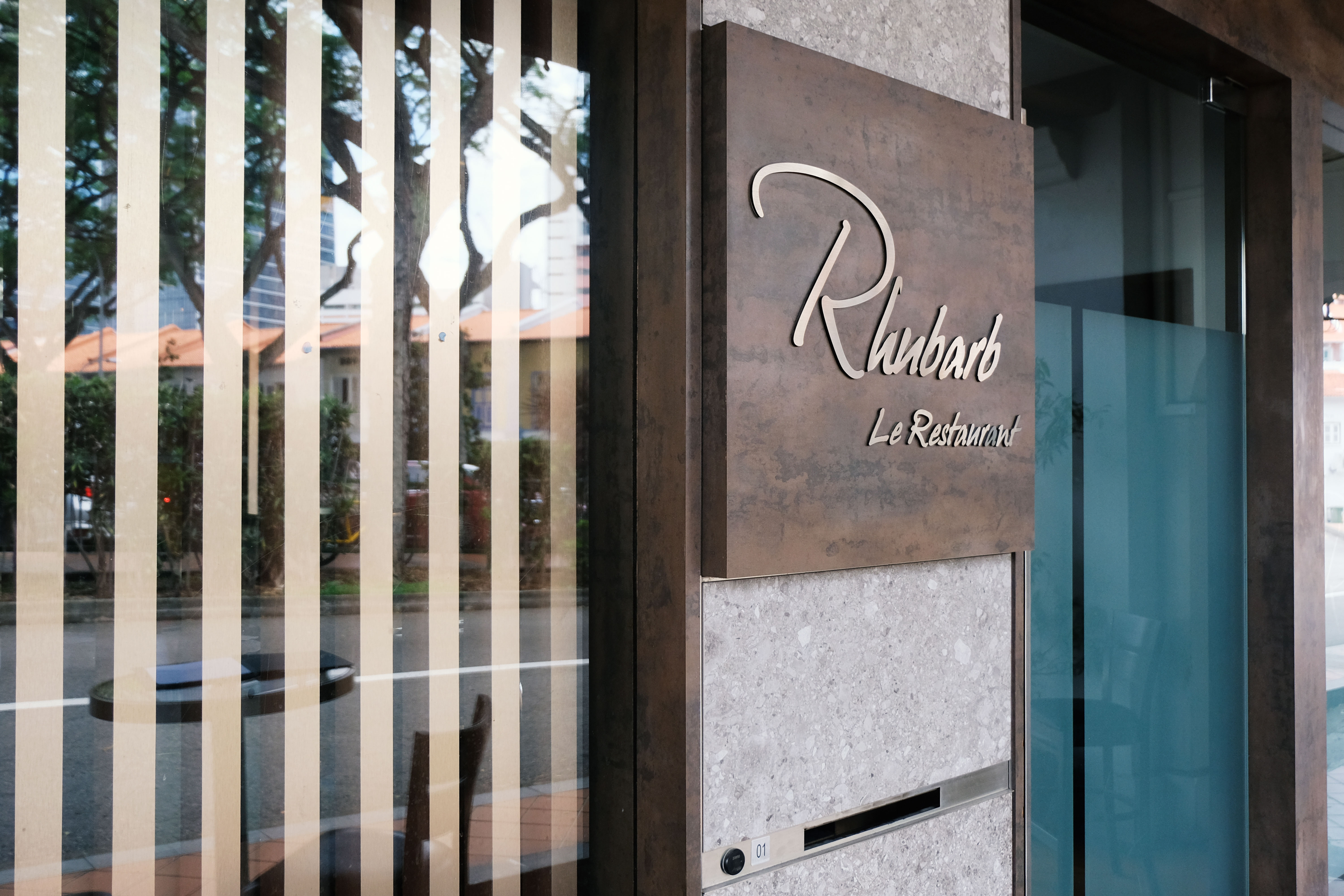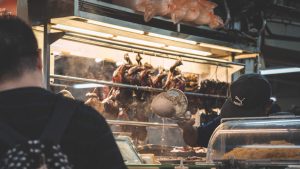His companion opens the door, eliciting from him the snarky response: “This doesn’t even look like a door.”
I expect my lunch to play out the same way.
Fish vaporised into foam. Dessert disguised as a sunny side up. Thankfully, I encounter none of these shenanigans. At Rhubarb, the food is honest; Chef Paul Longworth lets his ingredients speak for themselves.

In my mouth, the amuse-bouche splinters into a riot of textures: the hard crunch of the cone, the softer burst of the roe, the meaty chew of the hamachi, and, finally, the smooth indulgence of the cream. It is, in essence, a savoury ice-cream meant to be eaten in the cold heart of winter.

I am not quite enamoured with the jellied fish (need I say more?) and the caviar does nothing but proclaim conspicuous consumption. The cured hamachi in nori, however, is delicious; it is what the jellied hamachi aspires to be when it grows up.
The nori—crisp and umami—perfectly complements the hamachi by adding another dimension to its oceanic brine. The finger limes, looking like fish roe but bursting into zesty acid, are an inspired update to this classic Japanese pairing.

I immediately realise why it is justifiably termed ‘emulsion’ and not ‘soup’. The green foam somehow exists between two states. Upon eating, it diffuses into the aroma of sweet spring’s tender green shoots. Then I taste the soil from which they sprang: a vein of intense earthiness supplied by the black truffle puree. Individually, both components are impeccable.
However, I am slightly disappointed that they do not interact in any meaningful way, which is a shame, given the bowl’s poetic metaphor of the earth.

The seared breast is a heavy, meaty chew redolent of iron. I don’t enjoy it, but I can’t fault the way it is cooked. Chalk this up to my personal preference. Eating it with a permutation of the celeriac puree, pickled daikon, and delicious date and liquorice sauce (which I want to mop up with my tongue) does make the breast more palatable to me.
But the confit leg is divine. I don’t know how he does it, but Chef Longworth manages to encase the rich, juicy meat in a shatteringly crisp bonbon shell. It tastes of home-cooked food: a stew studded with carrots, onions, and celery, over which your mother has laboured the whole day. It is sophisticated, requiring technical virtuoso to introduce texture into the otherwise homogenous stew.
It is fun, too. I pick up the bonbon by the leg bone and eat it like the grown-up lollipop that it is. This is why Rhubarb is fully booked for a weekday lunch.

First, the positives. The fresh raspberry is the platonic ideal of a raspberry. I have never tasted one so creamy, soft, and sweet—choosing the right produce is as much a skill as manipulating it culinarily. Freeze-dried, the raspberry has a playful hint of salt that enhances the delightful lip-puckering sourness of the berry.
And I am bathed in a gentle and fragrant autumnal rain when I eat the lemon verbena ice cream. Its floral and herbal notes are shy, and all the better for that: when they meet my taste buds, their embrace is soft and snug and I never want to let go. Unfortunate, then, that the other components do not interact, and at their worst, interfere with the accomplishments.
The lemon verbena is paired with popping candy. I get it. The candy adds crunch and its fizzle is hard to replicate. But it is one dimensional, tasting purely of sugar. Eating it with the lemon verbena ice cream—or anything else on the plate, for that matter—destroys all complexity and leaves a metaphorically bitter aftertaste.
Imagine sandpapering a flower. Why would you do that? Chefs, please leave the popping candy in the hands of a four-year-old, where it belongs.

In total, my meal comes up to $114.17. That eye-watering number has the potential to make me feel like a socialite or a full-fledged socialist. For better or worse, when I leave, I start plotting how to make the pages of Singapore Tatler. Just kidding. What am I, fifty-years-old, with enough botox in my face to kill an entire safari of elephants?
Yes, that amount can pay for an entire week of groceries. 20 luxurious plates of cai png with fish. Feed an underprivileged child for a month, or longer. But unless you live a life of extreme utilitarianism (a la Peter Singer, a moral philosopher who argues that, even if you are hungry, as long as you are less hungry than a starving person, you should pay for their meals), you really have no basis for expressing incredulity over that.
Moreover, as Jay Raynor, famously acerbic food critic of The Observer, has pointed out, the moral outrage against blowing wads of cash on a meal is completely unwarranted and has no ethical basis. People spend hundreds, if not thousands, on BTS concerts, Lululemon sweatpants, arowanas. The profit margins on these products and experiences are much higher than that of a restaurant, yet such forms of gratification never seem as wrong or unnecessary as gastronomic ones.
Therefore, unless you are Peter Singer or a saintly, charitable monk who subsists on gruel, any outcry about the price of the meal stinks of hypocrisy, or its less obnoxious cousin, envy.
If you don’t enjoy food—why are you even reading this? Go and do something more productive with your time like lowering your risk of prostate cancer.
For the former, it is an unequivocal yes (a helpful summary for those who did not manage to detect the tone or content of my review: food at Rhubarb good but bird breast bad). For the latter—well, I don’t want to commit any category errors by comparing a fine-dining experience with buying a pair of Levi’s jeans or an indoor skydiving package. It’s all subjective, obviously. You are a unique individual like everybody else.
Alas, our wants are infinite and resources finite. We have to engage in some cognitive shortcuts to determine to which hedonistic entreprise our $100 should go.
If you don’t enjoy food—why are you even reading this? Go and do something more productive with your time like lowering your risk of prostate cancer.
But if you can tell the difference between ginger and galangal and think it’s a crime to watch videos while eating, it’s a no-brainer to go to Rhubarb. The dishes Chef Longworth serves will remind you that all food—shock horror—actually taste of something! Other than salt, sugar, or preservatives!
The experience there is made more brilliant if you enjoy being fawned over and treated deferentially even though you have done absolutely nothing in your life worthy of someone else’s respect. Waiter? I want a glass of equality, liberty, fraternity, and I want to throw it in your face. The service staff at Rhubarb are so polished that I am sure they will oblige and refill your refreshment even after you express your True Self.
Disagree with our taste-buds? Have a better idea on how to spend $100? Send us angry anonymous emails at community@ricemedia.co






